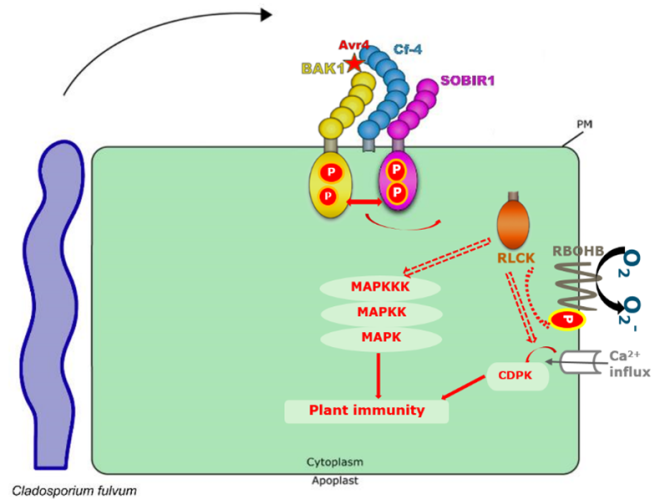
Project
How is immune signalling transduced downstream of receptor complexes present at the cell surface?
In this project, we aim to:
• Identify the cytoplasmic kinases (the so-called receptor-like cytoplasmic kinases (RLCKs)) that bridge the gap between the activated Cf-4/SOBIR1/BAK1 receptor complex present at the cell surface and downstream mitogen-activated protein (MAP) kinase cascades.
• Search for the MAP kinases involved in Cf-4 immune signalling by proximity-dependent labelling of identified RLCKs, followed by mass spectrometry
• Identify important RLCKs by performing proximity-dependent labelling with candidate MAP kinases known to play a role downstream of Cf-4
• Validation of the importance of the various RLCKs and MAPKs that have been identified by multiplex CRISPR/Cas technology in Cf-4-resistant tomato
Background
During plant growth and development, plants often suffer from a variety of stresses, including abiotic stresses (e.g., drought, extreme temperatures, high salinity) and biotic stresses (e.g., diseases and pests), and these stresses seriously affect our crop plants. Therefore, to rapidly contend against microbial infections, plants have evolved sophisticated, complex and effective defence mechanisms, including specific recognition of the invading pathogen, the activation of immune signal transduction cascades inside the cells, a swift transcriptional reprogramming and the actual activation of immune responses, which eventually reduce the damage caused by pathogens to a great extent. Studying the defence response mechanisms of plants under biotic stress is recognized as very significant in plant stress resistance research.
Project description
Plants deploy numerous cell surface-localized immune receptors to perceive microbe-derived effectors, which are proteins that are produced by pathogenic microbes with the aim to suppress defence responses. The Cf- resistance protein and its co-receptor SOBIR1 constitutively interact at the plasma-membrane of the host cells and this Cf-4/SOBIR1 complex acts like a two-component receptor-like kinase (RLK).
When the effector Avr4, secreted by the invading pathogenic fungus Cladosporium fulvum is perceived by Cf-4, the co-receptor BAK1 is recruited to the Cf-4/SOBIR1 complex. Subsequent trans-phosphorylation events have been shown to take place between the kinase domains of BAK1 and SOBIR1, and probably various downstream RLCKs will be specifically phosphorylated too. Subsequently, these activated RLCKs are probably released from the complex, and in their turn phosphorylate the RBOHB enzyme present in the plasma-membrane, thereby activating the enzyme and inducing the swift production of toxic reactive oxygen species (ROS). The defence signal is further amplified through a MAP kinase cascade and possibly also by the activation of so-called calcium-dependent protein kinases (CDPKs), which is probably caused by a strong Ca2+ influx, which eventually activates hypersensitive cell death (the HR) and resistance (Figure 1).

It is clear that RLCKs and MAP kinases play very important roles in plant immunity, but it is not known which RLCKs and MAP kinases are actually involved and how they perform downstream signalling.
We will focus on which RLCKs and MAPK(K)(K)s are actually involved in Cf-4-mediated resistance against C. fulvum and how they function in Avr4/Cf-4/SOBIR1-triggered downstream signalling.
The questions to be answered in this project are
- Which MAPK cascade is important for Avr4/Cf-4/SOBIR1/BAK1-mediated signalling in our model plant Nicotiana benthamiana and in tomato?
- Which RLCKs are required for the activation of ROS and/or the MAPK cascade and/or the HR upon perception of Avr4 by Cf-4?
- What is the location of the various RLCKs before and after immune signalling is being activated?
- What are the downstream substrates of the activated MAPKs and how do they eventually induce the expression of defence-related genes?
Results
Earlier, we have already obtained information that various RLCKs and MAPKs play very important roles in Cf-4-mediated plant immunity. Indeed, recently RLCKs have emerged as central components that fill the gap between cell-surface receptors and intracellular signalling cascades in plants. For example, the members from RLCK family VII-6, -7 and -8 are required for full Avr4/Cf-4-triggered ROS production in N. benthamiana. Besides, the members of RLCK-VII-7 are also important for the Avr4/Cf-4-triggered HR activation. Concerning the role of the various MAPKs, up till now we found that some MAPKs indeed play a role in regulating the Avr4-triggered HR and MAPK activation.